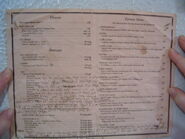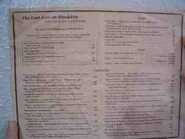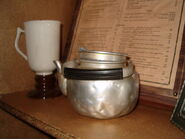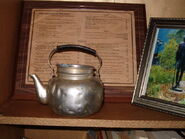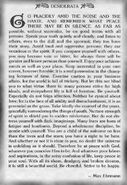The much-photographed front of the Last Exit; pictures of the interior are few and far between.
The Last Exit on Brooklyn was a University District coffeehouse, founded 1967 by Irv Cisski, who operated it until his death in the early 1990s. Home to chess players, go players, guitar players, two-bit hustlers, and coffeehouse intellectuals. On November 6, 1993, 6 months after Irv's death, it moved from its longtime location in the 3900 block of Brooklyn Ave. NE to the Upper Ave—the 5200 block of University Way NE. As part of the move the northbound lanes of University Way were closed for a parade where staff and customers marched up the Ave, some carrying the last chairs to move. After the move and a change of management and ownership it died a slow death.
The original place on Brooklyn was enormous (it seated about 80 at tables, and could cram in another 40 or so for music performances, plus 15 more on the patio out back), high-ceilinged, and, by mid-evening, as smoky as a circle of hell. Around the edge were marble tables, fashioned out of what had once been stall dividers in the rest rooms of the old King County Courthouse; the legs were truck differentials. In the center were big, round wooden tables that had once been in a cardroom; they'd been stripped of their felt tops, but their nature was clear by the cutout in each for what had been the dealer's position. On the back patio were two picnic tables, and a wooden bench. People often used the rail separating the patio from the parking lot below as additional seating.
Out of some combination of compliance with a poorly drafted law and a twisted sense of humor, Irv would periodically designate a table or two as a non-smoking area, usually in the middle of the room, about as effective as a quiet section in a bowling alley. The wallpaper was probably a health code violation. [It was grandfathered at the original location, but the health department did veto plans to transplant the wallpaper to the new location.] The tiny, heavily graffitied bathroom (OK, toilet: the sink was in the kitchen) was frequently painted, usually in one of those ugly pastels normally reserved for institutional use; graffiti, some of it genuinely witty, some of it genuinely not, would reappear before the paint was dry.
From the beginning there were open mic poetry readings on Wednesday. These readings were for the most part popular in the late sixties, playing to a full and appreciative house. However, they eventually declined to the point where Irv stopped this practice, replaced it with music, and the world rejoiced.
There was an upright piano of abominable quality, which was sometimes in tune, thanks to Blind Mike, who did a great job but always seemed to take it on when there were about 80 people in the place who had to either leave or listen to the process of tuning. On Monday nights there was an open mic for music, run for most of the Exit's lifetime by Mariide (of St. Elmo's Choir fame). Spontaneous jam sessions were pretty frequent (especially in the summer, on the porch out back); so was piano music, ranging in quality from magnificent to legally actionable. The policy for recorded music can most succinctly be described as "insane": Irv seems to have had a thing for recordings like Gheorghe Zamfir Does the Beatles' Hits or Sousa marches. Somehow Brian Eno's Before and After Science snuck onto the play list, as well.
And then there was that name. An obvious allusion to Hubert Selby's novel Last Exit to Brooklyn, one of the most depressing books ever written, and where the only eating establishment mentioned is a hideous greasy spoon. Surely the reason for the name was that Irv was a closet gay and the book had detailed descriptions of homosexuality in an era where such things were not discussed. An alternate theory is that Irv knew the title and knew it had some sort of beatnik connection. [Irv told one of the editors of this article that he wanted to name the place "The New World", but the customers revolted and hung the Last Exit sign for him on opening day; Irv claimed the novel "the most disgusting book ever written."]
There was usually art on the walls, usually for sale. The range of quality was broad: some pretty fine work from the likes of Paul Kuranko (who now creates the audio-visual technical designs for the Guggenheim Museums), Eddie Walker ([1] shows a still-extant mural of his across the street from the old Exit site at the University of Washington Ethnic Cultural Center; related artist statement at [2]), Ray Paul Nielsen, Linda Larson, and a cook who was only known as "Poppet", among others, but also one show that resulted in the regulars getting up a petition that the art should "at least look better than the wallpaper", which was understood to be a very low bar. The wallpaper was pasted directly onto the cement walls, and it hadn't been redone since 1967.
The Exit menu included the world's sloppiest peanut butter and jelly sandwich, soups that ranged from sub-Campbell's to gourmet depending on who was in the kitchen, and several snacks not found in nature (Mint-Coke anyone? Meatball Trailer? 1). The Exit was also famous for its apple pie with hot cinnamon sauce, a la mode. Originally, the coffee was strictly drip, but the Exit was among the pioneers of espresso in Seattle, and its espresso menu included a wonderfully indulgent concoction Irv called a Caffé Medici, whose ingredients included chocolate, whipped cream, and fresh orange peel. Plus a quasi-espresso item expositorily named an 'espresso float', which was made by pouring a shot of espresso into a coke glass, then adding Hersheys syrup, then ice cream, then more chocolate syrup. The huge, sloppy peanut butter and jelly sandwich, which one just about had to use a fork to eat, was Irv's idea of providing the down-and-out with a cheap, nutritious meal: Irv offered it close to his cost.
Espresso was the money-maker, of course. By the late 'Eighties, there were probably two dozen other places pulling espresso in the University District (and the Exit's huge, classic, tempermental, lever-pull machine originally installed in 1969 had been replaced with something a little more modern and slightly less liable to explode), but the Exit was still the place for coffee: some people came across the Lake from Bellevue for their morning shot of the dark stuff, then drove back to go to jobs that were also east of the lake, braving the 520 bridge twice.
In the summers of '83, '84, and '85, Irv's system of accounting for the wait staff was honesty. The waitperson would come in, walk to the cash register, open it without supervision, and stuff a wad of uncounted bills into the left hand pocket and a handful of uncounted coins in the middle apron pocket. The far right apron pocket was left empty for tips. The waitperson walked to the table, took the orders, served the food from the kitchen, then charged the customer at the table. What was due the Exit was kept in the Exit's two apron pockets of cash and coins; what was due the waitperson as a tip was placed in the right hand apron pocket. There was no need for the waitperson to count the begin-shift amount of bills and coins was unnecessary for the simple reason that the honesty system only allowed what was honestly the tip to pass into the right apron pocket. When Irv was asked how he would know if a waitperson was stealing, he petted downwardly on his mustache as was his habit, and allowed that on the few times he had been suspicious, he would move the waitpersons to different shifts to isolate the source of the problem.
The crowd, of course, was the point of the whole thing, and the reason it qualified as a "sight" on the Grey Line tour of Seattle: the highest level of chess play this side of New York (Washington State champions Viktors Pupols and Jim McCormick were longtime regulars and rivals, and professional chess champion Yasser Seirawan learned and mastered the game at those marble tables) and comparable levels at various other games (Seattle's current go club is, in some senses, a legacy of the Exit)( Irv's view of the games players" With the dog you get the fleas"); more musicians than you could shake a stick at (although, admittedly, a few you would have wanted to shake a stick at); bright teenagers; tarot readers; students and faculty from the University of Washington; travellers from around the world; charming con men; a few certifiable loonies; petty drug dealers (usually discreet, and usually only pot and hallucinogens, at least as long as Irv was alive); people with politics ranging from near-fascist through libertarian to revolutionary left. The Exit was the site of political meetings ranging from the followers of Lyndon Larouche to those of Bob Avakian and was the crucible of the Peace Heathens, and hence of The Peace Heathens' Seattle Crisis Resource Directory; in 1990-91 it served as an indoor outpost of the PeaceWorks Park vigil a mile away at Gas Works Park. The manager at the time of Irv's death was David Johnson, the son of the founder of the Open Door Clinic Lee Kirschner. Back in the revolutionary late sixties, Irv, out of entirely reasonable concerns, banned the use of cameras inside the establishment; he rarely made an exception to that rule; sketch artists were permitted, but they were expected not to draw anyone who objected. 2 He was concerned about the privacy of his customers and ensuring that leftists could hide out there if they wanted.
The "Free University of Seattle" occupied two or three vacant buildings across the street from the Last Exit in the late 1960s. The Free University offered courses in a variety of counterculture topics, periodically operated a free open air soup kitchen in the back, and offered a place to sleep for some of the homeless and runaway teens who also frequented the Exit.
The various groups just described were not, by any means, mutually exclusive. There were some fine chess-playing drug dealers, and no small number of artist- or musician-revolutionaries. The Exit was also well known as the place where you could find out (usually before the fact) about pretty much every social happening in the U. District counterculture, and there were also no small number of people for whom the Exit was a cruising ground: one visitor from Texas described the crowd as "barflies without alcohol". More accurately, those who were inclined toward that particular drug typically ducked out a block away to the College Inn Pub, indulged, and returned.
At breakfast time, the place was self-service, and you paid for your food (though not for your espresso) on a barely monitored honor system. The morning crowd overlapped the lunchtime and evening crowd, but was heavier on law students, U.W. faculty and staff, and, oddly enough, the U.W. staff carpenters, some of whom could be described as "blue collar intellectuals" and others who would have hit you with a hammer if you called them that.

Opening lines of Max Ehrmann's Poem 'Desiderata', which hung prominently on the wall near the piano
With rare exceptions, service was slow: a notice on the menu as good as said "if you're in a hurry, go elsewhere", and the line for espresso could be 30 minutes long on a busy night. Some of the wait staff (the gender-neutral term "waitrons" became current among the regulars circa 1980) were so hard to flag down that regulars joked about bringing signal flares. This was partly caused, and partly made up for, by Irv's tendency to hire about half of his staff based more on their looks than their table-waiting skills: the floor staff were, as a rule, appreciably more attractive than the kitchen staff. Irv would offer a job to people he thought needed work; he was more concerned with helping someone than providing excellent service, and he often defended his staff against customer complaints. The Exit was one establishment where the customer was not always right.
For a long time, the menus were only printed on one side. The reverse served as a notepad / sketchpad for whoever was at the table. They had everything from poetry to engineering sketches to games of hangman to chemical processes, reflecting the huge range of conversations that went on in the place. Irv had a huge box of old-scribbled-on menus that could probably have served as fodder for a dissertation in history or sociology. Unfortunately it appears to have vanished during the move.
Irv himself was a cantankerous guy; a semi-benevolent dictator, it was a rare month when he didn't ban someone from the place for an unspecified period, and often for an unspecified reason. He usually chose pretty well, but he could be petty, and the closest anyone ever got to an apology from him was for him to deny he'd ever kicked them out. Still, it was his kingdom, and no one in this city since his time has created one like it.
The best dishwasher Irv had was Don Itzel. Extremely intelligent, Don worked in a weapons lab (Lawrence Livermore?) until about 1960. He dropped out, he said, because he couldn't stand the knowledge of what his calculations meant, if they were put to use. He became enthralled with creating a personal mandala and it winding up warping his sense or reality. He loved reading ancient history. He never went back to physics, but became a great Scrabble player, who drove Viktors Pupols (many times WA state chess champion) nearly mad with his "luck" and was knowledgeable in subjects such as philosophy. Don passed away in 1996, at the age of 67.
Guitarist extraordinaire Darren Loucas worked several years at the Exit in his early 20s; Selene Vigil, later of 7 Year Bitch, briefly waited tables there.
Gallery
These images were found at the Last Exit Listing on Tribe.net.
Notes
1 The Meatball Trailer came on a hot dog bun, covered in cheese, and was served in a mug, with ketchup on the side. A correspondent remarks, "I can't remember as much about the meat ball trailer as I can those who ordered them. Generally the type who had no teeth."
One waitress used to "recommend" imaginary items like the Tuna Float and the Sardine Sundae, but the Tuna Melt and the Sardine Sandwich (an entire tin of sardines, on bread) were really on the menu, as was "Asparagus Tip Sandwich (in season)". Somehow the "season" never arrived, but Irv thought it added a touch of class to the menu.
Other unusual menu items were the Half Honey Bran Loaf and Ry Krisp with Cream Cheese.
2 A correspondent writes, "...the no camera edict. Once, NW magazine decided to shoot a bio of the place. Flier warnings were posted for weeks...and for all the fanfare of what a worldy and popular joint they boasted, it was clearly the deadest afternoon in years.
"Once I remember [name deleted] forcefully ripping a camera away from a Japanese tourist who made the mistake of taking a snapshot, God knows why. He emptied its contents and returned it to the bewildered and whimpering young girl. Personally, I thought he may have overreacted a little, but in the end, never one to miss such an opportunity, he redeemed himself by taking the girl out on a date or something. I often pondered if an evening out with such a local was worth the price of a roll of vacation film, not that the damsel had much choice. Somehow I doubted it, but perhaps it all depended on her level of interest in anthropology."
